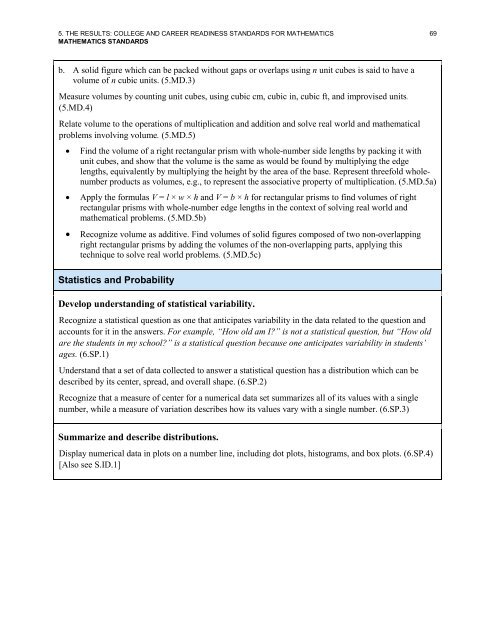CCRStandardsAdultEd
Create successful ePaper yourself
Turn your PDF publications into a flip-book with our unique Google optimized e-Paper software.
5. THE RESULTS: COLLEGE AND CAREER READINESS STANDARDS FOR MATHEMATICS 69<br />
MATHEMATICS STANDARDS<br />
b. A solid figure which can be packed without gaps or overlaps using n unit cubes is said to have a<br />
volume of n cubic units. (5.MD.3)<br />
Measure volumes by counting unit cubes, using cubic cm, cubic in, cubic ft, and improvised units.<br />
(5.MD.4)<br />
Relate volume to the operations of multiplication and addition and solve real world and mathematical<br />
problems involving volume. (5.MD.5)<br />
• Find the volume of a right rectangular prism with whole-number side lengths by packing it with<br />
unit cubes, and show that the volume is the same as would be found by multiplying the edge<br />
lengths, equivalently by multiplying the height by the area of the base. Represent threefold wholenumber<br />
products as volumes, e.g., to represent the associative property of multiplication. (5.MD.5a)<br />
• Apply the formulas V = l × w × h and V = b × h for rectangular prisms to find volumes of right<br />
rectangular prisms with whole-number edge lengths in the context of solving real world and<br />
mathematical problems. (5.MD.5b)<br />
• Recognize volume as additive. Find volumes of solid figures composed of two non-overlapping<br />
right rectangular prisms by adding the volumes of the non-overlapping parts, applying this<br />
technique to solve real world problems. (5.MD.5c)<br />
Statistics and Probability<br />
Develop understanding of statistical variability.<br />
Recognize a statistical question as one that anticipates variability in the data related to the question and<br />
accounts for it in the answers. For example, “How old am I?” is not a statistical question, but “How old<br />
are the students in my school?” is a statistical question because one anticipates variability in students’<br />
ages. (6.SP.1)<br />
Understand that a set of data collected to answer a statistical question has a distribution which can be<br />
described by its center, spread, and overall shape. (6.SP.2)<br />
Recognize that a measure of center for a numerical data set summarizes all of its values with a single<br />
number, while a measure of variation describes how its values vary with a single number. (6.SP.3)<br />
Summarize and describe distributions.<br />
Display numerical data in plots on a number line, including dot plots, histograms, and box plots. (6.SP.4)<br />
[Also see S.ID.1]


